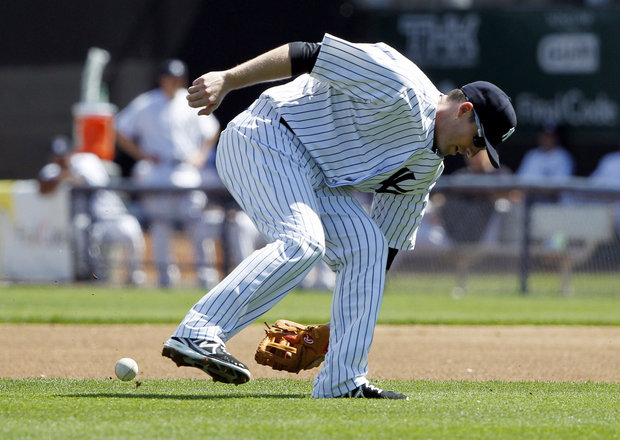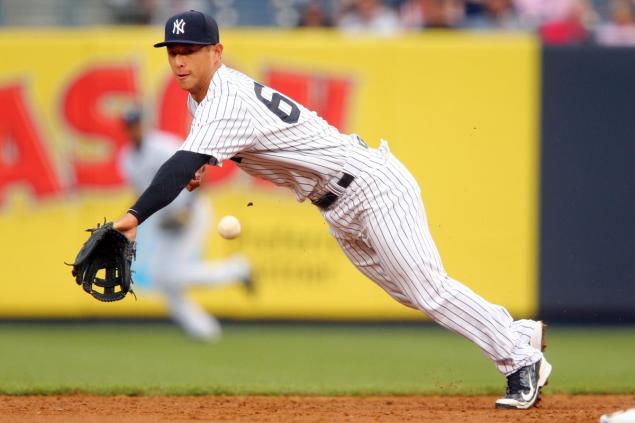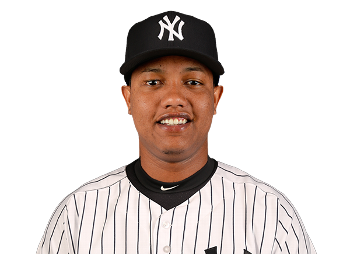
Robinson Cano batting for the Yankees during a game against the Oakland Athletics in 2008.
In Yankee Stadium the second base position has been nothing short of a disaster since Robinson Cano bolted for the Pacific Northwest following the 2013 season. The Yankees offered him a seven-year/$175 Million free-agent contract that he declined in favor of a ten year/$240 Million deal with the Seattle Mariners. Cano said he felt “disrespected” by the Yankees offer and that he “didn’t see any effort” to resign him.[1] Cano cited a desire to “[have] a contract to end [his] career [with]”[2]. Cano didn’t want to risk re-entering the free agent market in 2020 as a sluggish 37-year-old limited to the designated hitter role. Cano valued the extra three years of financial security the Mariners were willing to give him at an average of $24 Million/year more than he valued staying in the New York spotlight for an average of $25 Million/year over three fewer years. Can you really blame him for taking the extra $72 million in guaranteed money? Conversely, can you blame the Yankees for not wanting another unmovable, poison pill contract like A-Rod’s on the roster? When Cano left so did the best second baseman in baseball. Cano’s departure left the second base position in the Bronx an uncertainty, something that Yankees fans have taken for granted since Cano was called up in 2005.

Brian Roberts after striking out in the ninth inning of a game against the Houston Astros in 2014
The Yankees have pieced together their second base position with a combination of gum and duct tape since Cano departed for Seattle. Their first move at attempting to replace the void Cano left was signing Brian Roberts at the back end of his career. Entering the 2014 season he was a 36 year-old two-time former all-star who had not played over 100 games in a season since 2009. He was known during his prime to steal bases, hit doubles (he led the American league in 2004 and 2009 with 50 and 56 respectively), and play a solid second base (he holds a career .986 fielding percentage). The biggest knock against Roberts was his inability to stay healthy. In his last four seasons with the Baltimore Orioles before coming to New York he played in 192 games out of the 648 scheduled. This is just 29.6% of the Orioles total games from 2010-2013, further proving his reputation as a fragile player. Brian Cashman gambled on Roberts’ pedigree and offered him a one-year pact for $2 million. During the 2014 season Roberts was a shell of the player he was during his prime. He hit only .237 compared to his career batting average of .276, and flirted with the Mendoza line (.200) throughout most of the season. His fielding numbers declined as well, as he committed 34 errors and attained a fielding percentage of .974, .012 off his career pace. Although Roberts was active for his highest number of games since the 2009 season, he still only managed to play in a measly 91 games, or 56.2% of the Yankees scheduled contests. The Brian Roberts gamble was not paying off in the Bronx and it became time to look for a replacement for the once impactful veteran. Roberts retired following the 2014 season, at 36 years old he had suffered countless injuries throughout his career. His body was no longer able to keep up with the daily grind of the MLB schedule.
 Roberts and Cano’s comparable statistics from 2005-09. Cashman hoped to catch lightning in a bottle with Roberts for 2014, but his talent level was nowhere close to what it was during his prime.
Roberts and Cano’s comparable statistics from 2005-09. Cashman hoped to catch lightning in a bottle with Roberts for 2014, but his talent level was nowhere close to what it was during his prime.

Stephen Drew committing an error against the Philadelphia Phillies during a spring training game on March 4, 2015
Next came Stephen Drew whom the Yankees acquired in a deadline deal with their archrival, the Boston Red Sox. They gave up Kelly Johnson, a misfit utility infielder in order to acquire Drew. The selling point on Drew was that he was a key piece to the Red Sox 2014 World Series championship run. He was known in Boston for clutch hitting and playing a solid second base. Drew struggled throughout his first half-season in the Bronx, and was unable to bat higher than the Mendoza line. Drew finished the year with a .150 batting average, the worst in the majors. His struggles were often blamed that he was rusty due to the fact he sat out most of the first half of the season while looking for a suitable contract offer. Despite his struggles during the second half of the 2014 season, the Yankees decided to re-sign Drew on a one-year/$5 Million deal. He was not much better in 2015 for the Bombers, batting only .201 with a fluky 17 home runs[3]. In the second half of the season a slumping Drew was replaced with the likes of Rob Refsnyder and Dustin Ackley.
 Rob Refsnyder reaching for a bouncing ball at second base during the 2015 season
Rob Refsnyder reaching for a bouncing ball at second base during the 2015 season
Refsnyder is a work in progress; he was drafted in the fifth round of the 2013 draft out of the University of Arizona. Refsnyder had a statistically solid first season in the majors. He only committed one error in 52 chances for a .981 fielding percentage. Refsnyder also managed 13 hits in 43 at bats for a .302 batting average. This is a small sample size; however these are well above average numbers if he were able to maintain them for an entire season. A majority of Yankees fans believe Refsnyder was not given a fair shot at winning the second base job when it was up for grabs during last season’s playoff push. With the acquisition of Starlin Castro, Refsnyder has been relegated to AAA or as a backup infielder with the major league club.
 Dustin Ackley getting a base hit during a 2015 contest with the New York Mets
Dustin Ackley getting a base hit during a 2015 contest with the New York Mets
Dustin Ackley was acquired midseason from the Seattle Mariners in order to bolster the lineup with a left-handed bat and to provide flexibility as a second baseman, first baseman, outfielder, and designated hitter. Ackley was not viewed as an everyday second baseman by Brian Cashman and only appeared there in nine games for the Yankees. Ackley is not the solution to the second base problem in the Bronx. It was clear that the position had to be addressed during the offseason through the signing of a free agent or via trade.
 Ben Zobrist fielding a ground ball while playing second base for the Tampa Bay Rays
Ben Zobrist fielding a ground ball while playing second base for the Tampa Bay Rays
The biggest free agent name I believed the Yankees were going to pursue this offseason was Ben Zobrist. The Yankees discussed making a trade with the Oakland Athletics for Zobrist before the 2015 trade deadline, but Oakland ended up dealing him to the Kansas City Royals. Zobrist is known as a clutch hitter and a solid fielder that can play first base, second base, shortstop, left field, and right field. He is a two-time all star who even came in eighth place for the 2009 AL MVP while with the Tampa Bay Rays[4]. That year he batted .297 with 27 home runs, 91 RBI, and an eye-popping .405 OBP[5]. The biggest issue I perceive Brian Cashman had with Zobrist is his age: he will be 35 this upcoming May. The Cubs signed him to a relatively large contract, at four years/$56 Million. This is an average of $14 Million/year, similar to the contract an aging Carlos Beltran received. The Yankees are trying to get younger as a team, and avoiding the singing of veterans to long-term deals will get them closer to their goal. The signing of Zobrist made 25 year-old Starlin Castro expendable in Chicago.
from left: Starlin Castro, Adam Warren (top), Brendan Ryan (bottom)
On December 8, 2015 the Yankees agreed to a deal with the Chicago Cubs, sending pitcher Adam Warren and utility infielder Brendan Ryan to the Cubs in exchange for Starlin Castro. Castro was once considered the future of the Cubs organization and is already a three-time all-star in just six full seasons in the majors. He was moved from Shortstop to second base following the promotion of Addison Russell during the 2015 season. Castro struggled during most of 2013 and 2015, combining to bat just .254 across both seasons[6]. Russell is a consummate top of the lineup hitter who is used to seeing a lot of at-bats. He holds a career batting average of .281. His best season came in 2011 where he hit .307, with 22 steals, and a league leading 207 hits. He also led the league in at-bats that year with 674[7]. The part of Castro’s game he has to work on most is his fielding. He is only a career .963% fielder and has committed 138 errors in his six seasons. That will have to change if he hopes to remain at second base in the Bronx for the foreseeable future. With Castro, the Yankees have acquired an unfinished product. Although he is still extremely raw especially as an infielder, Castro is a noticeable upgrade over the players the Yankees have been plugging in at second base since Robinson Cano skipped town. Castro is a proven hitter that will see a lot of at-bats at the top of the Yankees lineup. Maybe a change of scenery will help Castro regain his 2011 form and ascend him to stardom in the Bronx. With Starlin Castro, the Yankees have solved their issue at second base. Although Castro is not the same caliber player Cano is, the Yankees have acquired a young, talented hitter who will improve his skills at second base over time. It is much easier to teach a player how to field than it is to teach a player how to hit. Hopefully the trade for Starlin Castro will pay off in favor of the Yankees. If the trade works out he will become a fixture in the Yankees infield for the next fifteen years. Let’s see what Starlin can do for the Bombers in 2016. At least the search for Cano’s successor is over. Let New York Sports Please keep you updated with all things Giants, Knicks, and Yankees. Thanks for reading!
from left: Starlin Castro and Robinson Cano
Footnotes:
[1] http://www.newsday.com/sports/columnists/david-lennon/robinson-cano-says-he-got-no-respect-from-yankees-1.6599125
[2] http://nypost.com/2013/12/12/robinson-cano-all-smiles-at-seattle-intro/
[3] http://www.baseball-reference.com/players/d/drewst01.shtml
[4] http://www.baseball-reference.com/players/z/zobribe01.shtml
[5] http://www.baseball-reference.com/players/z/zobribe01.shtml
[6] http://www.baseball-reference.com/players/c/castrst01.shtml
[7] http://www.baseball-reference.com/players/c/castrst01.shtml
Photo Credits:
- http://a.espncdn.com/combiner/i?img=/i/headshots/mlb/players/full/30450.png&w=350&h=254
- http://d39ya49a1fwv14.cloudfront.net/wp-content/uploads/2013/09/cano.jpg
- http://images.hngn.com/data/images/full/37731/major-league-baseball-second-baseman-brian-roberts.jpg
- http://www.thebaseballcube.com/reports/compare.asp
- http://image.nj.com/home/njo-media/width620/img/yankees_main/photo/17172956-mmmain.jpg
- http://assets.nydailynews.com/polopoly_fs/1.2296998!/img/httpImage/image.jpg_gen/derivatives/article_635/al-baseball.jpg
- http://cdn.riveraveblues.com/wp-content/uploads/2015/09/Dustin-Ackley1.jpg?ccc875
- http://cdn.chatsports.com/cache/3f/7e/3f7ededebb1d30ee7348b9cc7238dd49-original.jpg
- http://www3.pictures.zimbio.com/gi/Chicago+Cubs+v+St+Louis+Cardinals+j6Ueg-U29vWl.jpg
- http://www.rantsports.com/mlb/files/2014/04/Adam-Warren.jpg
- http://cdn.riveraveblues.com/wp-content/uploads/2013/09/Brendan-Ryan2.jpg?ccc875
- http://a.espncdn.com/photo/2011/0910/mlb_u_castro11_576.jpg
- http://i.usatoday.net/sports/_photos/2012/08/01/Chamberlain-returns-as-Yankees-thrash-Orioles-I11VTJ6M-x-large.jpg





